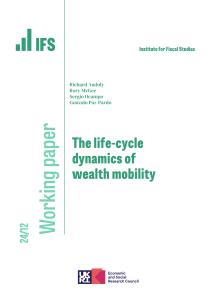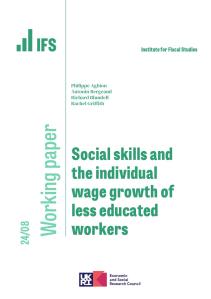Many people have defined contribution (DC) pensions that they no longer contribute to but are yet to start drawing from, and the number of people in this position will increase rapidly in future as a result of automatic enrolment into workplace pensions. There has been lots of concern about the likely proliferation of very small pension funds, which are relatively expensive to administer. But there is an important wider issue as well, that ‘deferred’ pensions that people no longer contribute to might provide declining value for money over time if people do not engage with them.
In this briefing note, we shed light on this issue using data from Profile Pensions. Profile Pensions makes pensions and investment advice available to the mass market and helps individuals to track down and consolidate their old defined contribution pensions. These data relate to a large anonymised sample of its potential customers aged mainly in their 50s who interacted with its services between April 2018 and December 2020.
Key findings
- Many deferred pensions held by a sample of those in their 50s are in schemes with relatively high charges by current market standards. Pension fees have fallen over time, yet deferred pensions often do not reflect these changing market conditions. The average annual fee for deferred pensions taken out in the 1990s is above 1.1% of fund value, but this falls for pensions taken out in the 2000s to around 0.9% and for those taken out in the 2010s to around 0.8%.
- This is driven by pensions taken out longer ago being particularly unlikely to have low fees. Among a sample of people in their 50s with deferred DC pensions, four-fifths of pensions started in 2013 were in a scheme with charges of 0.75% or less, compared with only one-in-four of pensions started a decade earlier in 2003 and one-in-nine of pensions started in 1993.
- In 2016–18, 40% of those aged 40-59 with at least one deferred DC pot were not confident that their income in retirement would give them the standard of living they hoped for. It is therefore particularly important that people obtain the best possible retirement outcome they can from the contributions they have made over working life.
- Even the difference between annual fees equivalent to 0.75% and 1.0% of funds can have an important effect when cumulated over many years. For example, for someone aged 50, this can imply a difference of 4.4% in resources at 67 assuming annual investment returns of 7.7% in both cases. For a 50-year-old with a pot of £21,000, this would amount to a difference of £2,000 in today’s prices at age 67.
- Having higher-than-average fees does not necessarily mean a pension scheme is not good value for money. However, investment performance over the past five years is generally similar among those schemes in our sample with higher charges and those schemes with lower charges, showing that the higher average fees among older pensions are not always offset by better returns.
- Another risk with older pensions is that the portfolio allocation may no longer be appropriate. In our sample, the share of funds invested in equities for deferred pensions started in the last decade was on average 45% among those aged 60 compared with 66% among those aged 50, consistent with people moving away from risky assets in the run-up to retirement. But among pensions started in the 1980s and 1990s, there is no difference in the average equity allocation depending on people’s current age; those aged 50 and 60 both have on average over 70% invested in equities. This suggests that for older savers, there is the risk that older pensions are inappropriately invested in riskier investments such as equities. Similarly, we find evidence that the investments made in older pensions are less well matched to an individual’s current risk preferences than those in pensions taken out more recently.
- Many of these issues could be solved with greater individual engagement with pensions, but this is very hard to achieve. Initiatives such as the Pensions Dashboard should help some people engage with their deferred pensions. But this is unlikely to be enough on its own to ensure appropriate investment strategies and value for money. The government and the Financial Conduct Authority may need to continue to look at wider initiatives and regulation to help encourage value for money, particularly for deferred DC pensions.













